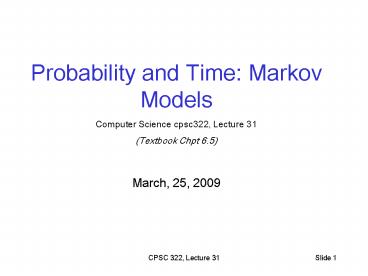Probability and Time: Markov Models - PowerPoint PPT Presentation
Title:
Probability and Time: Markov Models
Description:
For instance, the system keeps collecting evidence to diagnose ... state of the world at each specific point in time via a series of snapshots, or time slices, ... – PowerPoint PPT presentation
Number of Views:25
Avg rating:3.0/5.0
Title: Probability and Time: Markov Models
1
Probability and Time Markov Models Computer
Science cpsc322, Lecture 31 (Textbook Chpt
6.5) March, 25, 2009
2
Lecture Overview
- Recap
- Temporal Probabilistic Models
- Start Markov Models
- Markov Chain
- Markov Chains in Natural Language Processing
3
Big Picture RR systems
- Environment
Stochastic
Deterministic
Problem
Arc Consistency
Search
Constraint Satisfaction
Vars Constraints
SLS
Static
Belief Nets
Logics
Query
Var. Elimination
Search
Decision Nets
Sequential
STRIPS
Var. Elimination
Planning
Search
Markov Processes
Representation
Value Iteration
Reasoning Technique
4
Answering Query under Uncertainty
Probability Theory
Dynamic Bayesian Network
Static Belief Network Variable Elimination
Hidden Markov Models
Student Tracing in tutoring Systems
Monitoring (e.g credit cards)
BioInformatics
Markov Chains
Natural Language Processing
Diagnostic Systems (e.g., medicine)
Email spam filters
5
Lecture Overview
- Recap
- Temporal Probabilistic Models
- Start Markov Models
- Markov Chain
- Markov Chains in Natural Language Processing
6
Modelling static Environments
- So far we have used Bnets to perform inference in
static environments - For instance, the system keeps collecting
evidence to diagnose the cause of a fault in a
system (e.g., a car). - The environment (values of the evidence, the true
cause) does not change as I gather new evidence - What does change?
The systems beliefs over possible causes
7
Modeling Evolving Environments
- Often we need to make inferences about evolving
environments.
- Represent the state of the world at each specific
point in time via a series of snapshots, or time
slices,
Tutoring system tracing student knowledge and
morale
8
Lecture Overview
- Recap
- Temporal Probabilistic Models
- Start Markov Models
- Markov Chain
- Markov Chains in Natural Language Processing
9
Simplest Possible DBN
- One random variable for each time slice lets
assume St represents the state at time t. with
domain s1 sn - Each random variable depends only on the previous
one
- Thus
- Intuitively St conveys all of the information
about the history that can affect the future
states. - The future is independent of the past given the
present.
10
Simplest Possible DBN (cont)
- How many CPTs do we need to specify?
- Stationary process assumption the mechanism
that regulates how state variables change
overtime is stationary, that is it can be
described by a single transition model - P(StSt-1)
11
Stationary Markov Chain (SMC)
- A stationary Markov Chain for all t gt0
- P (St1 S0,,St) P (St1St) and
- P (St 1St) is the same
- We only need to specify and
- Simple Model, easy to specify
- Often the natural model
- The network can extend indefinitely
- Variations of SMC are at the core of most Natural
Language Processing (NLP) applications!
12
Stationary Markov-Chain Example
Domain of variable Si is t , i, p, a, h, e
We only need to specify
P (S0)
Probability of initial state
Stochastic Transition Matrix
P (St1St)
13
Markov-Chain Inference
Probability of a sequence of states S0 ST
P (St1St)
P (S0)
Example
14
Lecture Overview
- Recap
- Temporal Probabilistic Models
- Markov Models
- Markov Chain
- Markov Chains in Natural Language Processing
15
Key problems in NLP
Book me a room near UBC
- Assign a probability to a sentence
- Part-of-speech tagging
- Word-sense disambiguation,
- Probabilistic Parsing
- Predict the next word
- Speech recognition
- Hand-writing recognition
- Augmentative communication for the disabled
Summarization, Machine Translation.....
Impossible to estimate ?
16
Impossible to estimate!
- Assuming 105 words and average sentence contains
10 words . - Google language repository (22 Sept. 2006)
contained only 95,119,665,584 sentences
Most sentences will not appear or appear only
once ?
17
What can we do?
- Make a strong simplifying assumption!
Sentences are generated by a Markov Chain
P(The big red dog barks) P(TheltSgt)
18
Estimates for Bigrams
Silly language repositories with only two
sentences ltSgtThe big red dog barks against the
big pink dog ltSgtThe big pink dog is much
smaller
19
Learning Goals for todays class
- You can
- Specify a Markov Chain and compute the
probability of a sequence of states - Justify and apply Markov Chains to compute the
probability of a Natural Language sentence
20
Markov Models
Simplest Possible Dynamic Bnet
Markov Chains
We cannot observe directly what we care about
Hidden Markov Model
Add Actions and Values (Rewards)
Markov Decision Processes (MDPs)
21
Next Class
- Finish Probability and Time Hidden Markov Models
(HMM) (TextBook 6.5) - Start Decision networks (TextBook chpt 9)
Course Elements
- Assignment 4 is available on webCT . It is due on
Apr the 8th (last class). - You can now work on the first 3 questions. For
the 4th one you have to wait until next week.































